Steins;Gate PC Review: Time After Time
Nitroplus and 5pb.'s classic Japanese visual novel Steins;Gate finally gets an English language release thanks to localization specialists JAST USA. Was this time-travelling tale worth the wait?
This article first appeared on USgamer, a partner publication of VG247. Some content, such as this article, has been migrated to VG247 for posterity after USgamer's closure - but it has not been edited or further vetted by the VG247 team.
I've never seen the Steins;Gate anime, and consequently knew nothing about it save for the fact its title had an errant semicolon in the middle of it; a quirk of its nomenclature seemingly designed to confound and infuriate copy editors the world over.
In retrospect, I'm glad that I'd never watched the anime prior to playing the game -- no matter how often people told me that it was brilliant -- because part of the joy I've found in this astonishingly well-crafted visual novel is in its world- and character-building: the slow drip-feed of information about its setting and main cast that gradually builds to one of several different, equally fascinating climaxes.

This isn't to say that there's nothing here for fans of the anime, of course; it's an opportunity to spend some intimate time with the characters involved, and particularly to get inside the head of the main protagonist Rintaro Okabe, one of the most fascinating lead characters I've enjoyed the company of in quite some time. Not only that, but there's a number of alternative narrative paths that you can proceed down; the anime follows the somewhat difficult-to-attain "true" path from the game, whereas the game can lead you down a number of different routes that explore individual characters and their own personal stories in varying degrees of depth. Like any good visual novel, you don't quite get the full picture of what is going on until you've seen everything; replays are encouraged and rewarded with new artwork, new scenes and fascinating new narrative moments.
But let's back up a moment; there's a distinct possibility that, like the me of a couple of weeks ago, you knew the name Steins;Gate but not what it represented -- or perhaps you've never even encountered it at all. What's it all about?
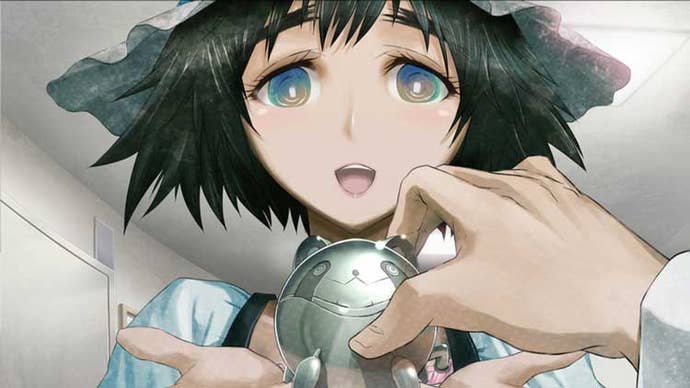
Steins;Gate is ostensibly a story about time travel and "worldlines" -- the different paths down which the seemingly linear timeline may proceed based on past events. Although this isn't inaccurate -- a significant portion of the story involves exploring what might happen if you fiddle around with the past via various means -- it's actually much more of a character-driven tale, with the emphasis firmly on the main cast and their relationships with one another rather than the sci-fi angle.
Leading up the cast is the aforementioned Rintaro Okabe, the protagonist and player character. Okabe is a chuunibyou, an individual afflicted with "middle school second year syndrome," or, to put it more clearly, the apparent belief that he has special powers that put him above and beyond the rest of humanity. In reality, Okabe is nothing more than an 18-year old student with a penchant for inventing utterly useless gadgets, but in his mind he's the mad scientist Hououin Kyouma, the man who will one day bring chaos to the world.
Except it's not quite that simple. The game quickly raises questions over whether Okabe genuinely believes the nonsense he spouts on a regular basis -- nonsense which voice actor Mamoru Miyano delivers with admirable aplomb, it must be said -- or if he's just doing it to keep up a facade. Matters are further complicated once the time travel and worldline aspect come into play; early in the game, it becomes apparent that Okabe has the peculiar and apparently unique ability to perceive changes in the worldline, even as the people around him have their memories seemingly "overwritten" by the universe. It makes for a fascinating character that the narrative takes great delight in exploring in great detail. Since he's not only the protagonist but also the first-person narrator of the whole experience, the quirks of his personality will, for many readers, put across the impression of an unreliable narrator -- a storytelling technique which the visual novel medium is particularly well-suited to explore, arguably more so than any other type of game.
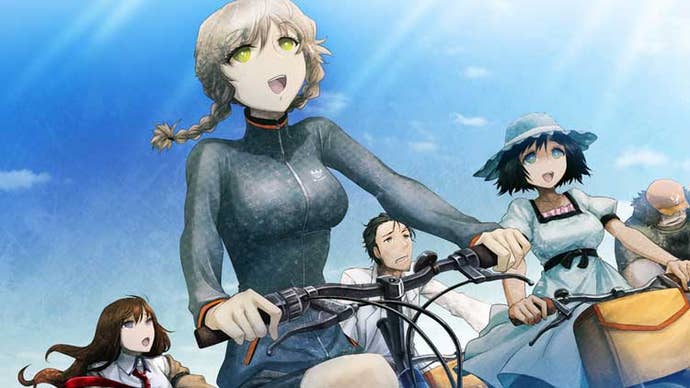
Okabe is supported by a diverse and interesting cast of characters, most of whom continually subvert expectations despite, in many cases, initially appearing to play to conventional anime tropes. Girl genius Kurisu Makise initially appears to be a textbook tsundere, for example, what with her perpetual grumpiness and insistence that she's "not doing this for you or anything," but there's a lot more going on there than initially meets the eye. Similarly, cheerful genki girl Mayuri may initially seem to be an airheaded, rather dim character -- a trait apparently emphasized by her banana obsession, frequent utterances of "Mayushii doesn't get it…" and insistence on greeting everyone by singing "tutturu" at them -- but over time, the game reveals plenty of hidden depth to her personality, along with how two seemingly completely different people such as Okabe and Mayuri might have come to be together.
The game uses its characters not only to advance the plot, but also to provide commentary on various aspects of Japanese and otaku culture. There's frequent references to slightly bastardized versions of real-life cultural phenomena throughout the game -- Japan's popular message board 2channel is unsubtly represented as "@channel", for example, and indeed part of the game's narrative is delivered through the medium of posts on the forum rather than conventional narration and dialogue.
In fact, herein lies one of the game's greatest strengths. The use of fictionalized versions of real-world phenomena plus established urban legends such as the John Titor story gives the game's setting a very "authentic" feel while still remaining accessible and understandable to those who aren't familiar with otaku culture as a whole -- or indeed those people who are familiar, but perhaps haven't delved as far down the rabbit hole as others. An extensive in-game glossary provides full definitions not only for otaku terminology used in the game's dialogue, but also for the real-world scientific theories and hypotheses that form the basis for much of the game's sci-fi angle.
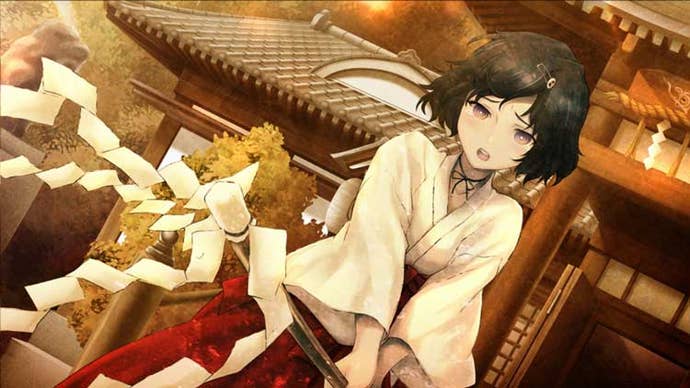
This isn't to say that you need to be a hardcore otaku to appreciate Steins;Gate, though a basic understanding of certain aspects of Japanese culture will undoubtedly help. Rather, the game observes and critiques numerous aspects of Japanese culture and media, frequently lampshading itself in subtle manners without ever resorting to breaking the fourth wall and addressing the player directly. Your actions throughout the game have a noticeable influence on the world as a whole, too; there's some particularly interesting material surrounding Tokyo's notorious Akihabara district that forms the main setting of the game, how it has come to be dominated by moe culture in recent years, and what it might be like if that never happened.
And speaking of actions, the way you interact with the game is unique in the medium of visual novels: rather than being confronted with explicit, often binary decision points at predefined moments in the narrative, Steins;Gate instead makes use of what it calls the "Phone Trigger" system. What this means is that as the story unfolds, Okabe will receive calls and email messages on his phone, which can be popped up from the side of the screen so long as he has it on him at that moment, and you can subsequently choose how to respond -- do you answer the call or ignore it? Do you answer the email or delete it? How do you respond to the email? Your choices here ultimately impact the scenes you'll see down the road, and in a pleasing twist not often seen in this sort of game, inaction -- i.e. doing nothing -- is usually an option as well as the more explicit choices presented to you. Not only that, but the game assumes the player has a certain degree of intelligence and curiosity, too; there are a number of moments where it's possible to pull out the phone and call or message someone, but the game doesn't force you to do so or indeed even make a big noise about it being a possibility at that moment. The most you'll get is a bit of Okabe's narration pondering whether or not he should call someone; fail to pick up on the cue and the story will simply advance, the opportunity lost.
The one mildly frustrating aspect of this means of interaction is that it's not always entirely clear what your choice is going to lead to, particularly when it comes to in-game email. Responding to an email is based on clicking on hyperlinked keywords in the sender's message, and this triggers a predefined response from Okabe, which you then send with an additional click. Trouble is, there's no way of cancelling out of the reply once Okabe has typed it, meaning that if you clicked on a keyword thinking it would say one thing and actually -- as frequently happens -- Okabe acts like a jerk instead, you're stuck with it. Ultimately this is a minor issue thanks to the ability to save at any time and the fact that there are no "wrong" choices, only those that will lead you down different narrative paths, but it would perhaps have been nice to have the opportunity to get a little more information before making a choice.
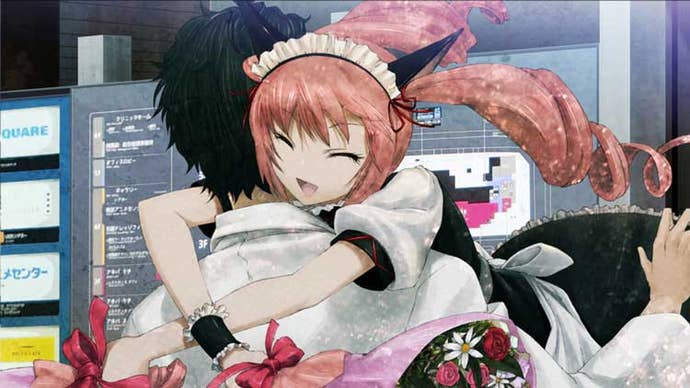
Looking at it another way, though, this restriction is actually sort of in keeping with the themes of the narrative. Chaos theory's "butterfly effect" plays a big role in the overall story, and thus it makes a certain amount of sense that the game doesn't make the consequences of an action immediately obvious. It also keeps the narrative progression feeling organic, natural and realistic; after you've sent an email in real life you don't get to "take it back," after all, and when someone calls your phone you only have a moment to decide whether or not to answer it.
The sheer number of micro-decisions you have to make over the course of Steins;Gate make it one of the more complex visual novels out there. Reaching a specific ending is much more than a case of simply picking the right options; obtaining the "true" ending involves triggering a number of flags along the way through means that might not necessarily be immediately obvious to our natural gamer instincts to click on everything as often as possible. That's fine, though; it's actually rather fun to "go on instinct" for at least one playthrough and see where you end up; the fast-forward function makes subsequent runthroughs (perhaps armed with a walkthrough) a painless process, and the game's built-in achievements system gives a good idea of some things to try along the way if you're struggling to discover scenes you haven't seen before.
Ultimately, whether or not Steins;Gate will appeal to you will be determined by your patience for interactive fiction and visual novels. As with most other examples of the visual novel medium, this isn't a "game" in the traditional sense; the vast majority of your time will be spent reading narration and dialogue, then clicking the mouse to advance to the next text window. This isn't a short read, either; a single playthrough will likely take you somewhere in the region of 20-30 hours depending on how quickly you read, and the opening half of the game is almost entirely character development and exposition rather than "action." Subsequent playthroughs can be made significantly shorter through the aforementioned fast-forward function, though, making it a straightforward process to see the other endings and "collect" all the rather wonderful artwork seen throughout the game.
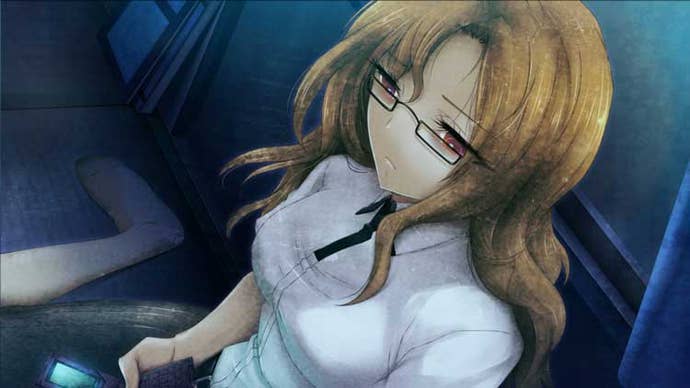
For those willing to put in the time and effort, then, Steins;Gate is a remarkable work. It's an expertly crafted -- and, crucially, well translated -- piece of interactive fiction with some wonderful world- and character-building, and one that tells a fascinating, compelling and, at times, unpredictable story. It makes expert use of all the elements of the visual novel medium as a whole -- text, images, music, sound, voice acting, the element of choice -- to tell its tale, and the result is a truly memorable narrative experience well worth exploring for yourself.
The Nitty Gritty
- Visuals: Rather than adopting the usual clean, smooth lines of other visual novels, Steins;Gate adopts a visual style all of its own, with character eyes being oddly hypnotic and the whole thing being overlaid with a distinctive grimy, scratched-up aesthetic.
- Music and Sound: Some catchy tunes complement the on-screen action well; meanwhile, the Japanese-language voice acting is of remarkably high quality, packed with emotion and helping to bring a strong sense of drama to the experience.
- Interface: The game assumes a certain amount of intelligence on the player's part and doesn't include a fourth wall-breaking tutorial or, in most cases, explicit prompts to do something. Instead, your interaction with the game is purely diegetic, giving the narrative flow a very organic, natural feel.
- Lasting Appeal: This is a long read that demands a significant time investment to get the most out of it. A single playthrough will likely take you 20-30 hours, and you'll need to see all the endings to get the full picture. Should keep you busy for a while!
ConclusionMaking excellent use of the visual novel medium to tell its story, Steins;Gate is a beautifully crafted piece of interactive fiction that blends character drama, sci-fi and critique of popular culture into a compelling and memorable whole.








